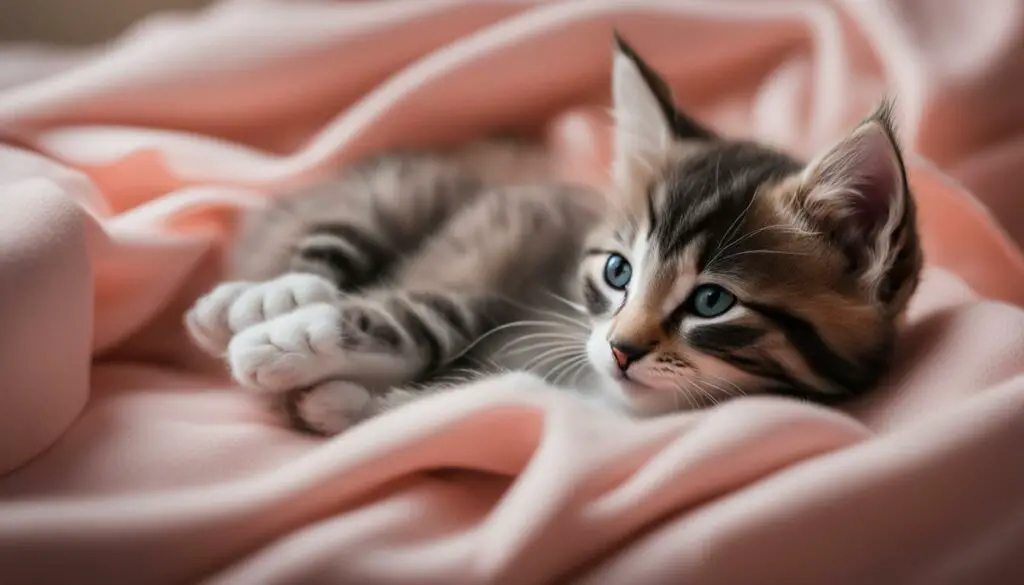Greetings! I’m here to provide you with a comprehensive guide on effective kitten swollen anus treatment. If your furry companion is experiencing discomfort and pain due to a swollen anus, it’s essential to understand the causes, symptoms, and appropriate treatments.
The anal sacs in cats, located on either side of the anus, can become inflamed or infected, resulting in a swollen anus. This condition can cause discomfort and distress for your precious kitten, but fear not, there are effective ways to provide relief and ensure their well-being.
Key Takeaways:
- Anal sacs in cats can become inflamed or infected, leading to a swollen anus.
- Common causes of a swollen anus in kittens include anal gland problems, allergies, parasites, constipation, trauma, tumors, and infections.
- Signs of a swollen anus in kittens may include scooting, licking or biting at the anal area, hair loss around the base of the tail, reluctance to defecate, and the presence of a swollen area beside the rectum.
- Treatment for anal sac disease in kittens depends on the underlying cause and may involve expressing the sacs, administering antibiotics, and providing pain relief.
- Home remedies such as warm compresses, Epsom salt baths, aloe vera, and dietary changes can help soothe a swollen anus in cats.
What are the anal sacs?
The anal sacs, also known as anal glands, are two small pouches located on either side of the anus in cats. These sacs are lined with sebaceous glands, which produce a foul-smelling fluid. The main function of the anal sacs is to act as territorial markers for cats, as the scent of their secretions helps to communicate information to other cats in the area.
However, the anal sacs can sometimes become inflamed or infected, leading to a condition known as a swollen anus. When this happens, the anus may become red, swollen, and painful for the kitten. Swelling in the anal area can be uncomfortable and may require treatment to provide relief and prevent further complications.
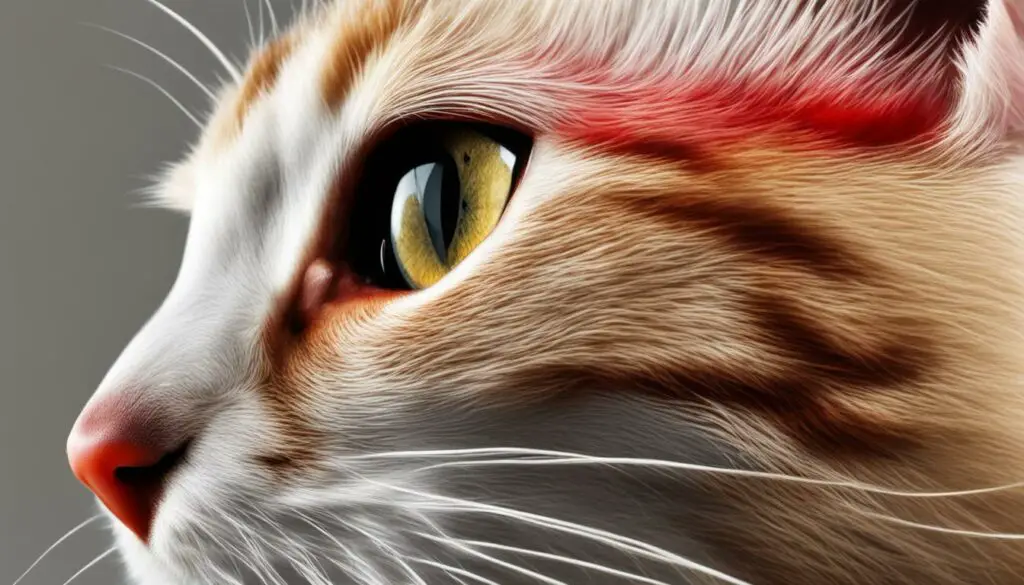
It is important to note that anal sac issues are more common in certain breeds of cats, such as Persians and Himalayans, due to their specific anatomy. However, any cat can experience problems with their anal sacs, especially if they become impacted or infected.
Understanding the function and structure of the anal sacs is crucial in identifying and treating issues that may arise. In the following sections, we will explore the common causes, symptoms, and treatment options for a swollen anus in kittens, as well as home remedies and the importance of veterinary care in addressing these issues.
Common causes of a swollen anus in kittens
When a kitten develops a swollen anus, it can be a cause for concern for pet owners. Understanding the common causes of this condition can help identify the underlying issue and seek appropriate treatment. Here are some of the possible reasons for a swollen anus in kittens:
- Anal gland problems: The anal sacs located on either side of the anus can become inflamed or infected, leading to swelling.
- Allergies: Kittens can develop allergies to certain foods or environmental factors, causing inflammation in the anal area.
- Parasites: Worms or other parasites can irritate the anal region, resulting in swelling and discomfort.
- Constipation: When a kitten is constipated, the straining during bowel movements can cause the anus to become swollen.
- Trauma: Any injury or trauma to the anal area can lead to swelling and pain.
- Tumors: While rare, tumors in or near the anus can cause swelling and require medical attention.
- Infections: Bacterial or fungal infections can affect the anal area and result in a swollen anus.
It’s important to note that these are just some of the common causes of a swollen anus in kittens. If your kitten is experiencing this condition, it’s best to consult with a veterinarian for a proper diagnosis and treatment plan.
| Cause | Symptoms | Treatment |
|---|---|---|
| Anal gland problems | Scooting, licking or biting at the anal area, foul odor | Expressing the anal sacs, antibiotics if infected |
| Allergies | Redness, itching, inflammation | Identifying and avoiding allergens, anti-inflammatory medication |
| Parasites | Visible worms, excessive itching | Anti-parasitic medication |
| Constipation | Difficulty passing stool, straining | Dietary changes, laxatives if necessary |
| Trauma | Injury, swelling, pain | Cleaning the wound, pain relief medication if needed |
| Tumors | Visible growth, pain, discomfort | Surgical removal, chemotherapy if necessary |
| Infections | Redness, swelling, discharge | Antibiotics, antifungal medication |
It’s crucial to seek veterinary care if your kitten has a swollen anus. The veterinarian will be able to determine the exact cause of the swelling and recommend appropriate treatment options to alleviate discomfort and promote healing.
Kitten Anal Swelling Remedies and Treatment for Swollen Anus in Young Cats
When it comes to addressing a swollen anus in kittens, it is important to identify and alleviate the underlying causes of discomfort. Recognizing the symptoms is the first step in providing appropriate treatment. Common signs of a swollen anus in kittens include frequent scooting, excessive licking or biting at the anal area, hair loss around the base of the tail, reluctance to defecate, and the presence of a swollen area beside the rectum. These indicators suggest that your kitten may be experiencing discomfort and should be evaluated by a veterinarian.
Once a diagnosis has been made, there are various remedies and treatment options available to relieve the swelling. Depending on the cause of the swollen anus, your veterinarian may recommend dietary changes, increased hydration, and warm compresses to provide relief. Additionally, topical solutions such as aloe vera or witch hazel can help soothe the area and reduce inflammation. It is important to note that while these remedies may provide temporary relief, they do not address the underlying cause of the swelling and should be used in conjunction with veterinary care.
In some cases, more extensive treatment may be necessary. If the swollen anus is caused by anal gland issues, your veterinarian may need to express and flush the anal sacs to relieve the discomfort. If an infection is present, oral antibiotics may be prescribed. It is crucial to follow your veterinarian’s guidance and complete the full course of any prescribed medications to ensure proper healing.
| Kitten Anal Swelling Remedies | Treatment for Swollen Anus in Young Cats |
|---|---|
| Warm compresses | Dietary changes |
| Aloe vera | Increased hydration |
| Witch hazel | Expressing and flushing anal sacs |
| Topical coconut oil | Oral antibiotics for infections |
Remember, while these remedies and treatments may provide relief, it is crucial to consult with a veterinarian to identify the underlying cause of the swollen anus and ensure proper care for your kitten’s well-being.
Treating anal sac disease in kittens
When it comes to treating anal sac disease in kittens, the approach will depend on the underlying cause of the condition. Impacted anal sacs may require manual expression and flushing to relieve the swelling. This can be done by a veterinarian or under their guidance if you feel comfortable doing it at home. In cases where an infection is present, oral antibiotics may be prescribed to help clear the infection.
In addition to manual expression and medication, there are other treatments that can provide relief for your kitten. Pain relief medication can help alleviate discomfort, while warm compresses applied to the anal area can promote healing and reduce inflammation. It’s important to ensure that your kitten is comfortable and has a clean and hygienic environment during the treatment process.
In severe cases where other treatments have not been effective, surgical intervention may be necessary. This is typically a last resort and is only recommended when all other options have been exhausted. Surgical treatment may involve removing the anal sacs completely to prevent further complications.
Table: Comparison of Treatment Options for Anal Sac Disease in Kittens
| Treatment Option | Benefits | Considerations |
|---|---|---|
| Manual expression and flushing | Relieves immediate discomfort and swelling | Requires skill and guidance from a veterinarian |
| Antibiotics | Treats underlying infections | May cause side effects and require a full course of treatment |
| Pain relief medication | Provides relief from discomfort | Should be used under veterinary guidance |
| Warm compresses | Reduces inflammation and promotes healing | Requires regular application and monitoring |
| Surgical intervention | Can provide a long-term solution | Should only be considered as a last resort |
It’s important to consult with a veterinarian to determine the most appropriate treatment plan for your kitten. They will be able to assess the underlying cause and recommend the best course of action to address the swollen anus and provide relief for your furry friend.
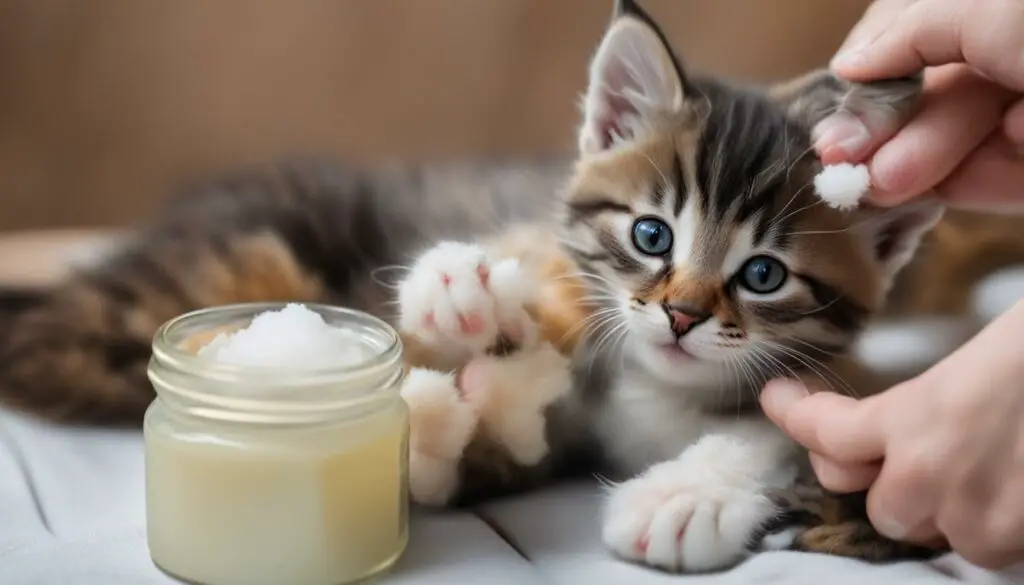
Potential complications of anal sac surgery in kittens
Surgical treatment for anal sac abscesses or other complications can carry some risks, including the potential for bowel control issues. In some rare cases, surgery may be necessary to remove the anal sacs completely. It is important to discuss the risks and benefits of the procedure with your veterinarian to make an informed decision about the best course of action for your kitten.
Complications that may arise from anal sac surgery include:
- Bowel control issues: Surgery on the anal sacs can disrupt the normal function of the muscles in the anus, leading to difficulties in controlling bowel movements. This can result in fecal incontinence or difficulty in passing stools.
- Infection: Like any surgical procedure, there is a risk of infection following anal sac surgery. Your veterinarian will prescribe antibiotics to reduce the likelihood of infection, but it is important to monitor the surgical site for any signs of inflammation, discharge, or fever.
- Delayed healing: The surgical site may take time to heal completely, and complications such as wound breakdown or delayed wound healing can occur. Your veterinarian will provide you with instructions on how to care for the surgical site and monitor for any signs of abnormal healing.
- Recurrence of anal sac issues: In some cases, removing the anal sacs may be necessary if they are causing recurrent problems. However, there is a possibility that the issues may still persist even after surgery. Your veterinarian will discuss the likelihood of recurrence and provide recommendations for long-term management if needed.
It is crucial to closely follow your veterinarian’s post-operative instructions and attend any follow-up appointments to ensure proper healing and to address any concerns or complications that may arise.
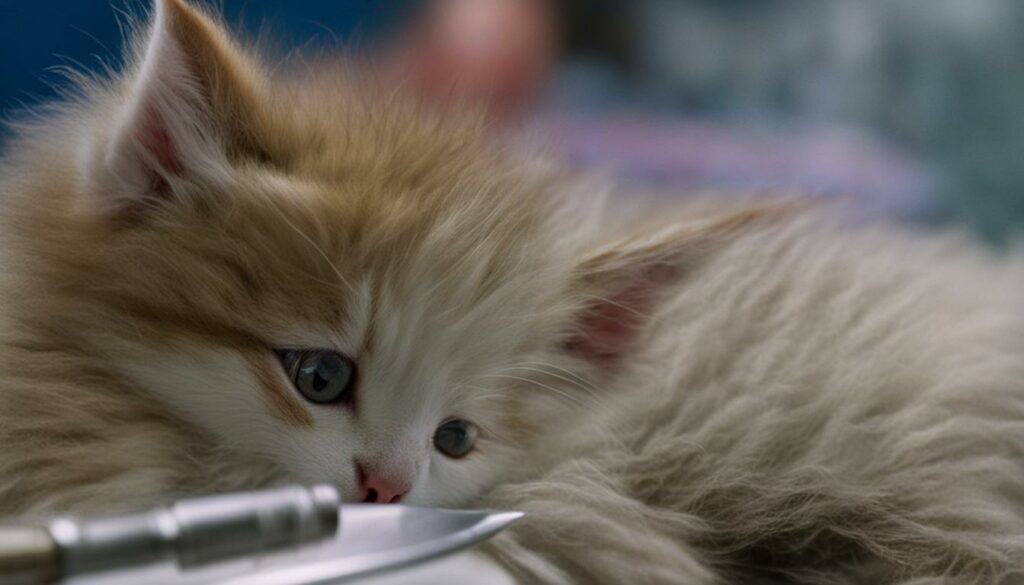
Potential complications of anal sac surgery in kittens
| Complications of Anal Sac Surgery | Description |
|---|---|
| Bowel control issues | Surgery may disrupt the normal function of the anus muscles, leading to difficulties in controlling bowel movements. |
| Infection | There is a risk of infection following surgery. Antibiotics may be prescribed to reduce the likelihood of infection. |
| Delayed healing | The surgical site may take time to heal completely, and complications such as wound breakdown or delayed healing can occur. |
| Recurrence of anal sac issues | In some cases, removal of the anal sacs may be necessary if they are causing recurrent problems, but there is a possibility of the issues persisting even after surgery. |
Home Remedies for Cat Swollen Anus
If your kitten is experiencing a swollen anus, there are several home remedies that can help provide relief and reduce inflammation. These remedies can be used as complementary treatments alongside veterinary care. Remember to consult with your veterinarian before trying any new remedies or treatments.
Warm Compresses
Applying warm compresses to the swollen area can help soothe discomfort and reduce inflammation. Use a clean cloth soaked in warm water and gently press it against the anus for a few minutes at a time. Repeat this process a few times a day to alleviate symptoms.
Natural Topical Solutions
Several natural topical solutions can provide relief for a swollen anus in cats. Aloe vera gel, witch hazel, or coconut oil can be applied to the affected area to help reduce inflammation and promote healing. Be sure to choose high-quality and pet-safe products for your kitten.
Dietary Changes and Increased Hydration
Incorporating dietary changes can help improve your kitten’s overall health and potentially reduce anal gland issues. Consider adding fiber-rich foods to their diet, such as canned pumpkin or psyllium husk. Additionally, ensuring your kitten stays well-hydrated can help prevent constipation, which can contribute to anal gland problems.
Remember, while these home remedies can provide temporary relief, it is crucial to seek veterinary care for proper diagnosis and treatment. Your veterinarian can guide you on the best course of action for your kitten’s specific condition and ensure their overall well-being.
Expressing Your Cat’s Anal Glands at Home
Expressing a cat’s anal glands at home can be a useful technique to relieve discomfort and address certain anal gland issues. However, it’s important to approach this procedure with caution and seek guidance from a veterinarian before attempting it. Here are some important steps to consider:
- Gather the necessary materials: Before starting, make sure you have latex gloves, lubricant, mild soap, warm water, and clean towels or wipes.
- Hold the cat still: It’s crucial to ensure your cat is calm and comfortable during the process. You may need someone to help you hold the cat securely and gently.
- Trim excess hair: If the cat has long or tangled fur around the anal area, it’s recommended to carefully trim it to prevent any complications during the expression.
- Clean the area: Use mild soap and warm water to gently clean the external area around the anus to maintain hygiene.
- Locate the glands: With the help of gloves and lubricant, carefully locate the anal glands on both sides of the anus. They feel like small pea-shaped structures.
- Apply gentle pressure: Using your thumb and forefinger, apply gentle pressure on each gland simultaneously to express the fluid. Be prepared for the fluid to be released forcefully.
- Clean up: After expressing the glands, clean the area with mild soap and warm water, then pat it dry with a clean towel or use pet wipes.
- Reward the cat: Provide your cat with positive reinforcement, such as treats or praise, to help them associate the experience with something positive.
Remember, it’s essential to stop the expression immediately if you notice any signs of pain or discomfort in your cat. If in doubt, consult your veterinarian who can guide you through the process or perform the expression for you.
“Proper technique and caution are vital when expressing a cat’s anal glands at home. It’s always best to consult with a veterinarian before attempting this procedure to ensure the safety and well-being of your feline friend.”
To visualize the steps better, here’s a table summarizing the process:
| Steps | Instructions |
|---|---|
| Gather materials | Latex gloves, lubricant, mild soap, warm water, clean towels or wipes |
| Hold the cat still | Ensure the cat is calm and secure |
| Trim excess hair | Carefully trim long or tangled fur around the anal area |
| Clean the area | Use mild soap and warm water to clean the external area |
| Locate the glands | With gloves and lubricant, locate the anal glands on both sides of the anus |
| Apply gentle pressure | Use thumb and forefinger to apply gentle pressure and express the fluid |
| Clean up | Clean the area with mild soap and warm water, pat dry with a towel or use pet wipes |
| Reward the cat | Provide positive reinforcement such as treats or praise |
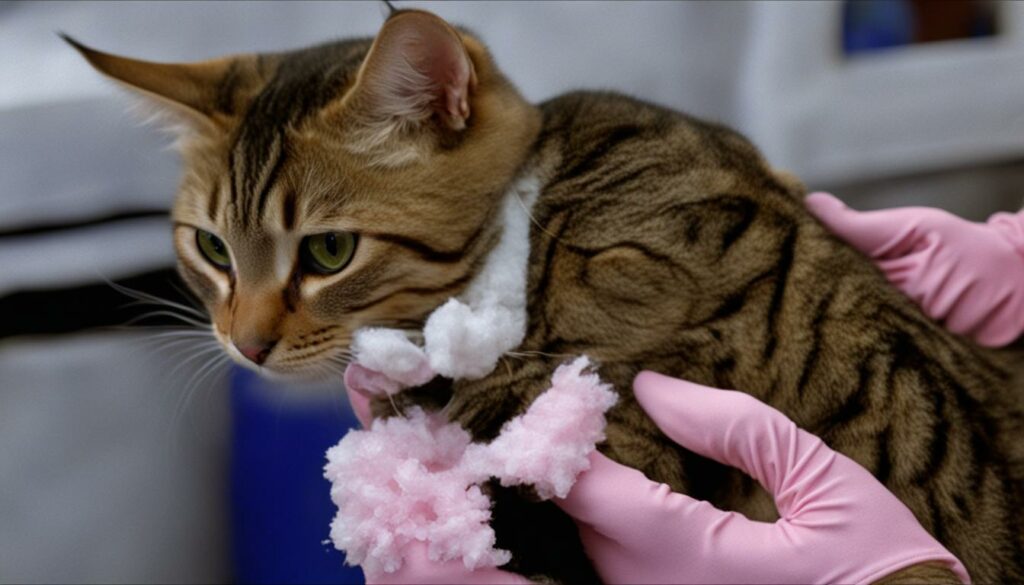
When to consider expressing a cat’s anal glands
Knowing when to consider expressing a cat’s anal glands is important for identifying and addressing potential anal gland issues. While most cats do not require regular anal gland expression, there are specific signs that indicate the need for this procedure.
If your cat is displaying symptoms such as scooting, excessive licking or biting at the anal area, a foul odor, redness or inflammation, painful defecation, or blood in the feces, it may be time to consider expressing their anal glands. These signs can indicate anal gland problems that require attention and treatment.
Furthermore, if you notice any changes in your cat’s behavior, such as increased discomfort or difficulty in bowel movements, it is essential to consult with a veterinarian. They can provide a proper assessment and determine whether expressing the anal glands is necessary for your cat’s health and well-being.
Remember, the decision to express a cat’s anal glands should always be made in consultation with a veterinarian as they can provide guidance and ensure the procedure is performed safely and effectively.
How to Express a Cat’s Anal Glands at Home
If your cat is experiencing a swollen anus, expressing their anal glands at home can provide relief. However, it is important to proceed with caution and seek professional help if your cat shows signs of pain or discomfort during the process. Here is a step-by-step guide on how to express a cat’s anal glands:
Gather the necessary materials:
- Gloves
- Cotton balls or gauze pads
- Pet-safe lubricant
- Warm water and mild soap
- Treats or rewards for your cat
It is essential to use gloves to protect yourself from any potential infections or irritations. Additionally, having cotton balls or gauze pads, a pet-safe lubricant, warm water, and mild soap will help ensure a hygienic and comfortable process for your cat.
Follow these steps to express the anal glands:
- Hold your cat securely and gently restrain them.
- If necessary, trim any excess hair around the anal area to improve accessibility.
- Clean the area around the anus with warm water and mild soap, carefully removing any debris or fecal matter.
- Locate the anal glands, which are located at the 4 and 8 o’clock positions around the anus. They should feel like small, pea-sized bumps.
- Gently apply pressure to the glands using your gloved fingers or a cotton ball wrapped in a tissue.
- Express the fluid by applying gentle pressure in a downward and outward motion. Be cautious not to apply excessive force or cause your cat any pain.
- Clean up any mess with warm water and mild soap, ensuring proper hygiene.
- Reward your cat with treats or praise to make the experience positive.
Remember, expressing a cat’s anal glands at home should only be done if recommended by a veterinarian. It is essential to consult with a professional to ensure the well-being of your cat and address any underlying issues causing the swollen anus.
| Pros | Cons |
|---|---|
| Provides immediate relief for your cat | Can be uncomfortable or painful for your cat if done incorrectly |
| Cost-effective compared to professional veterinary care | Risk of injury or infection if proper hygiene and technique are not followed |
| Allows you to monitor your cat’s anal gland health | May not address the underlying cause of the swollen anus |
| Convenient and can be done at home | May not be suitable for cats with severe or recurrent anal gland issues |
Expressing a cat’s anal glands at home can be a helpful interim solution for providing relief to your cat. However, it is crucial to consult with a veterinarian to ensure the proper diagnosis and treatment for the underlying cause of the swollen anus.
How often to express a cat’s anal glands
Expressing a cat’s anal glands should only be done when necessary, as most cats are able to naturally empty their glands through regular defecation. However, some cats may experience chronic anal gland issues that require regular expression. The frequency of expression can vary depending on the individual cat’s needs and underlying conditions.
For cats with recurrent anal gland problems, it may be necessary to express the glands every three to four weeks. This can help prevent the buildup of fluid and alleviate discomfort. However, it is important to consult with a veterinarian before attempting to express the glands at home to ensure proper technique and minimize the risk of injury.
If your cat does not have ongoing anal gland issues but exhibits signs of discomfort or inflammation, such as scooting or excessive licking, it may be necessary to express the glands on an as-needed basis. Keep an eye on your cat’s behavior and consult with your veterinarian if you notice any changes in their anal area or overall well-being.
| Signs that may indicate the need for anal gland expression: | Signs that may indicate the need for veterinary attention: |
|---|---|
|
|
It is important to note that while expressing a cat’s anal glands can provide temporary relief, it does not address the underlying cause of the swollen anus. Veterinary care is essential to properly diagnose the root cause of the issue and provide appropriate treatment.
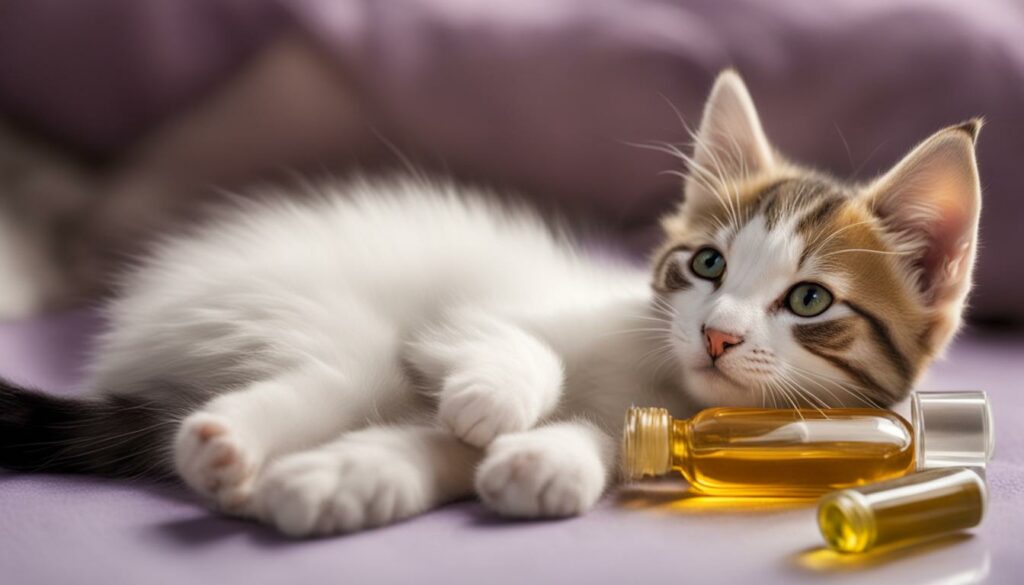
The importance of veterinary care for anal gland issues
When it comes to treating anal gland issues in kittens, veterinary care plays a crucial role in ensuring the best possible outcome. While home remedies can provide temporary relief, they do not address the underlying cause of the swollen anus. A veterinarian can provide a thorough assessment and recommend appropriate treatments based on the specific needs of your kitten.
Diagnosis: One of the key reasons why veterinary care is important is to accurately diagnose the cause of the swollen anus. A veterinarian will perform a physical examination and may also conduct additional tests, such as anal gland fluid analysis or imaging, to determine the root cause of the issue.
Treatment: Once a diagnosis is made, a veterinarian can provide targeted treatment for the anal gland infection. This may include oral antibiotics to combat bacterial infections or anti-inflammatory medications to reduce inflammation and discomfort. In some cases, the anal sacs may need to be expressed and flushed to remove impacted material.
Monitoring and Follow-up: Veterinary care ensures that your kitten’s progress is closely monitored. A veterinarian will assess the response to treatment and make any necessary adjustments to ensure the best outcome. They can also provide guidance on preventive measures and ongoing care to help manage and prevent future anal gland issues.
| Veterinary Care for Anal Gland Issues | Benefits |
|---|---|
| Accurate Diagnosis | Proper identification of the underlying cause |
| Targeted Treatment | Specific therapies based on the cause and severity of the issue |
| Professional Monitoring | Ongoing assessment of progress and adjustments to treatment |
| Preventive Care | Guidance on preventive measures and long-term management |
Remember, while expressing a cat’s anal glands at home can provide temporary relief, it should only be done under the guidance of a veterinarian. Veterinary care is essential for accurately diagnosing the cause of the swollen anus and providing appropriate treatment. By seeking professional help, you can ensure the health and well-being of your kitten.
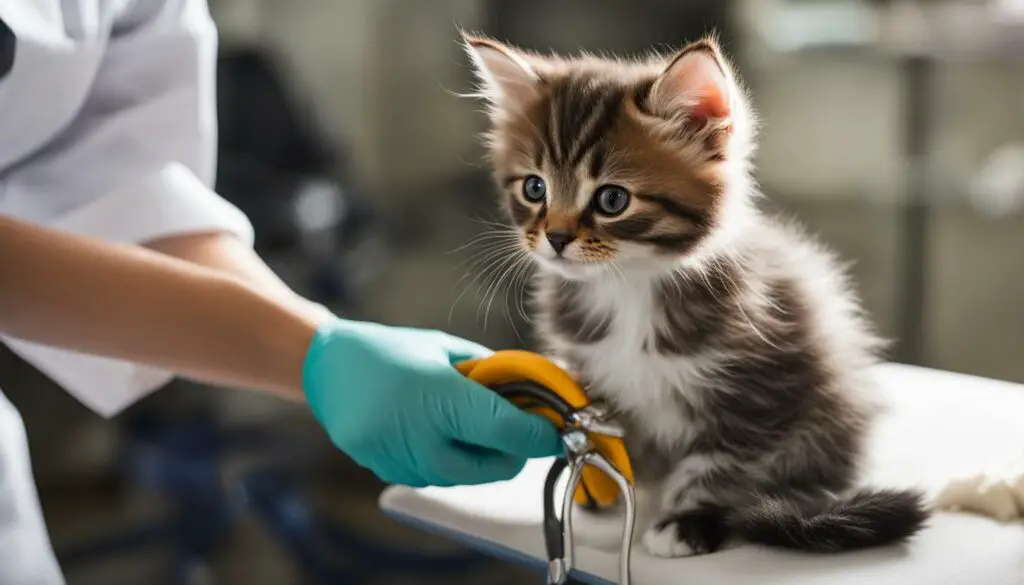
Alternatives to Manual Anal Gland Expression
If manual anal gland expression is not suitable or effective for your cat, there are alternative treatment options available. These alternatives aim to address the underlying causes of anal gland issues and provide relief for your kitten’s swollen anus.
Dietary Changes
One alternative approach is to make dietary changes to promote healthy bowel movements and prevent anal gland problems. A high-fiber diet can help regulate digestion and prevent constipation, which is a common cause of anal gland issues in kittens. Consult with your veterinarian to determine the appropriate diet for your cat’s specific needs.
Medications
In some cases, medications may be prescribed to manage anal gland inflammation and infection. Antibiotics can help treat bacterial infections, while anti-inflammatory drugs can reduce inflammation and alleviate discomfort. Your veterinarian will determine the most suitable medication based on the underlying cause of your kitten’s swollen anus.
Surgical Removal of Anal Sacs
In severe or chronic cases of anal gland issues, surgical removal of the anal sacs may be recommended. This procedure, known as anal sacculectomy, removes the source of the problem and can provide long-term relief. However, it is a more invasive option and should be considered as a last resort after exploring other alternatives.
| Treatment Option | Description |
|---|---|
| Dietary Changes | A high-fiber diet to promote healthy bowel movements and prevent constipation. |
| Medications | Prescribed medications to manage inflammation and infection. |
| Surgical Removal of Anal Sacs | Invasive procedure to remove the anal sacs, providing long-term relief. |
Remember, it is essential to consult with your veterinarian to determine the most appropriate course of action for your kitten’s swollen anus. They will be able to provide a thorough examination, diagnose the underlying cause, and recommend the most effective treatment option. Don’t hesitate to seek professional help to ensure the health and well-being of your furry friend.
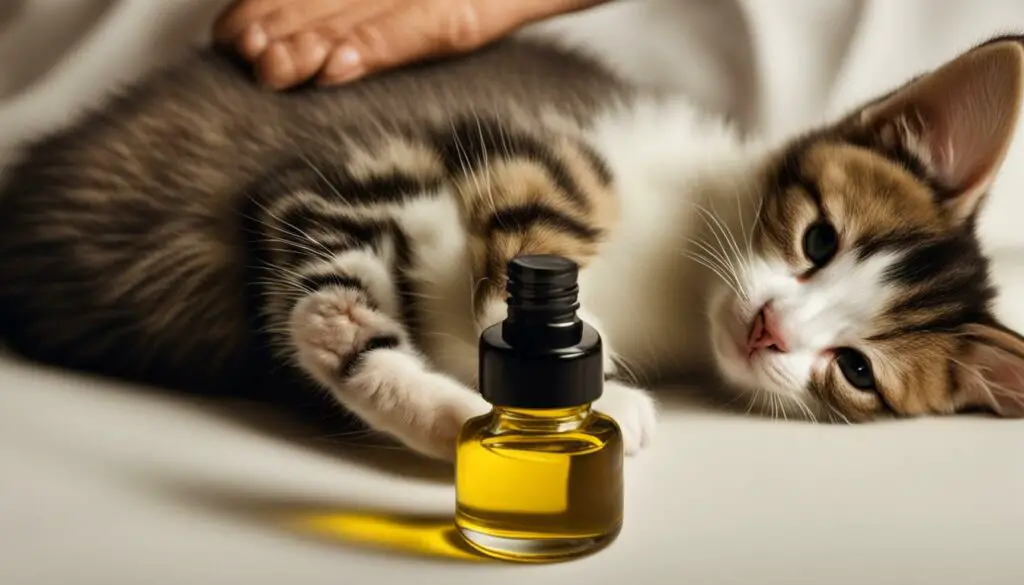
Section 14: Conclusion
Dealing with a swollen anus in kittens can be distressing, but remember that appropriate treatment is available to provide relief. While home remedies like warm compresses, Epsom salt baths, and natural remedies can offer temporary comfort, seeking veterinary care is crucial for a proper diagnosis and targeted treatment plan.
Expressing a cat’s anal glands at home should only be undertaken with guidance from a veterinarian to avoid causing harm. Although manual expression may be necessary in some cases, it’s important to consult with a professional to determine the best course of action, as surgical removal of the anal sacs may be required for chronic issues or complications such as anal gland abscesses.
Remember, a veterinarian will offer the expertise needed to accurately diagnose and treat the underlying cause of your kitten’s swollen anus. By seeking veterinary care, you can ensure that your furry companion receives the most appropriate care and prevent further discomfort or complications in the long run.
FAQ
What are anal sacs?
Anal sacs are small pouches located on either side of the anus in cats that produce a foul-smelling fluid and act as territorial markers.
What causes a swollen anus in kittens?
A swollen anus in kittens can be caused by anal gland problems, allergies, parasites, constipation, trauma, tumors, or infections.
What are the symptoms of a swollen anus in kittens?
Symptoms of a swollen anus in kittens may include scooting, licking or biting at the anal area, hair loss around the base of the tail, reluctance to defecate, and the presence of a swollen area beside the rectum.
How is anal sac disease in kittens treated?
The treatment for anal sac disease in kittens depends on the underlying cause and may include expressing and flushing the anal sacs, oral antibiotics for infections, pain relief medication, warm compresses, or surgical treatment in severe cases.
What are the potential complications of anal sac surgery in kittens?
Potential complications of anal sac surgery in kittens include the potential for bowel control issues, and in rare cases, the need for complete removal of the anal sacs.
Are there any home remedies for a swollen anus in cats?
Yes, there are several home remedies that can provide relief for a swollen anus in cats, including warm compresses, Epsom salt baths, aloe vera, witch hazel, coconut oil, dietary changes, increased hydration, chamomile tea, slippery elm bark, and calendula.
Can I express my cat’s anal glands at home?
Expressing a cat’s anal glands at home is possible but should only be done if recommended by a veterinarian to avoid causing further discomfort or injury.
When should I consider expressing my cat’s anal glands?
You should consider expressing your cat’s anal glands if your cat is showing symptoms such as scooting, excessive licking or biting, foul odor, redness or inflammation, painful defecation, or blood in the feces.
How do I express my cat’s anal glands at home?
Before attempting to express your cat’s anal glands at home, gather the necessary materials, hold the cat still, trim excess hair if necessary, clean the area, locate the glands, gently apply pressure to express the fluid, clean up any mess, and reward the cat afterwards.
How often should I express my cat’s anal glands?
Most cats do not require regular anal gland expression, as their glands should be able to empty naturally. However, some cats with chronic issues may need their glands expressed every three to four weeks, while others may only need it when they show signs of discomfort.
Is veterinary care necessary for anal gland issues?
Yes, veterinary care is essential for diagnosing and treating the underlying cause of a swollen anus in kittens. A veterinarian can provide a proper assessment, recommend appropriate treatments, and address any complications or recurrent issues.
Are there alternatives to manual anal gland expression?
Yes, in some cases, surgical removal of the anal sacs may be necessary as an alternative to manual expression. Consult with your veterinarian to determine the most appropriate course of action.
What is the importance of veterinary care for anal gland issues?
Veterinary care is important to accurately diagnose and treat the underlying cause of a swollen anus in kittens. A veterinarian can provide appropriate treatment and address any complications or recurrent issues.
What is the conclusion for kitten swollen anus treatment?
Treating a swollen anus in kittens requires proper veterinary care for accurate diagnosis and appropriate treatment. Home remedies can provide some relief, but should be used in conjunction with professional guidance. Expressing a cat’s anal glands at home should be done under the guidance of a veterinarian to avoid causing harm to the cat.
Source Links
- https://drhomeremedies.com/home-remedies-for-cat-swollen-anus/
- https://www.thewildest.com/cat-health/express-cat-anal-glands
- https://vcahospitals.com/know-your-pet/anal-sac-disease-in-cats

